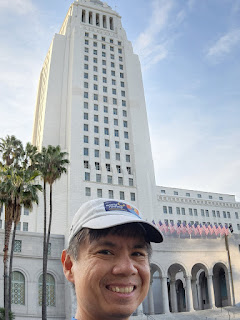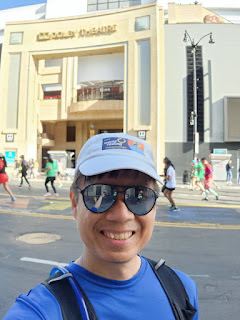 |
| Off by a second?! I'll acknowledge the slower time. |
After my troubles with Long Covid, i was really hoping for a "triumphant return to marathoning" by at least finishing less than 5:00. Such was not to be. Maybe i've undergone some actual permanent physiologic changes. Maybe i'm just getting old. Whatever it is, i don't like it, and i hope i can train my way out of it; to wit, i will focus on strength and proper running form for the next cycle.
On a positive note, i was able to achieve a negative split. At mile 13, my watch reported that my half marathon split was in the vicinity of 2:35-ish. I had an inkling (delusion!) that i could run the next half in around 2:20, so i dialed up the pace for my run intervals. I felt like i was doing generally okay until mile 20 or so, when my quads started complaining. Around mile 25, while speeding up for my finishing kick, both my legs just completely cramped up. At least in contrast to CIM 2022, when i had to stop moving altogether, i merely slowed down to a walk for around 2 minutes and then gingerly started jogging. I was never able to get a good finishing kick, but at least finished the race "running." My second half was completed in roughly 2:32-ish. Not much of a negative split, but i'll still take it.
I wonder if i just went out too slow. My cramping at the end would seem to imply otherwise, but i think there may have been another, more sinister reason for that.
In all honesty, i feel like i haven't learned to properly hydrate for marathons. After plenty of hemming and hawing on race week, i somehow convinced myself that my 1.5 L Camelbak would provide enough hydration. Unfortunately, it felt warmer than the weather report indicated (more on this later), and i chugged on that thing more than i usually do. I also didn't take advantage of the aid stations, only taking water from them about halfway in. Well, i RAN OUT of water around mile 22. Considering that i never needed to pee on the course, i was probably running pretty dehydrated. Even though i didn't necessarily run out of water at that race, my most recent CIM finish was also marred by cramping at the end, which i believe was also driven by dehydration. I need to get better at this. Maybe if i had hydrated better and gone out faster, maybe... maybe... Bah.
(On another note, i wonder how much time i wasted just stopping to take pictures along the way. Still, i didn't go all the way to Los Angeles to just run through the city and ignore my surroundings. And it wasn't really that many selfies.)
 |
| Chinatown. |
 |
| City Hall. |
 |
| An entrance to Echo Park. |
 |
| A fountain at Echo Park. |
 |
| The Dolby Theater. |
 |
| The Chinese Theater. |
 |
| Rodeo Drive. |
What's done is done. Nothing to do but learn the lessons, adjust, and move on.
RACE NOTES:
1. Upon arrival at Dodger Stadium two days before the race, while there were a few volunteers motioning us in the right direction, there were no actual signs indicating "Expo This Way." It seemed like anyone's guess as to where they should park or in which way they should actually head. I ended up parking BEHIND the expo, basically going in through the exit, and having to walk all the way through the event to the entrance at the other end just to get my bib. The exhibitors themselves were the usual assortment of vendors. There was a small wall of names. In sum, i would say that it was a bad experience just because of the lack of proper directions.
 |
| There i am! |
2. Despite the organizers' admonition to arrive at the start at 5:30 AM, we ended up LEAVING our Airbnb (around 5 miles away) at that time. We took I-5 into Dodger Stadium (traffic was horrendous at the exit), and i was dropped off with the other runners at around 6:30 AM. One cannot overstate how bad LA traffic can be. A friend of mine availed of the shuttle from Century City to the starting line (roughly 16 miles), and the trip took at least an hour. At least there was an ample amount of porta-potties at the start, so it took me only 20 minutes to use one. I was still able to get to the corral by 7 AM. (On a side note, i was assigned to Corral "Open" but seemed to accidentally wander into Corral E).
 | |
|
 |
| Enough porta-potties at the start. I got in and out in around 20 minutes. |
 |
| About to cross the starting line. |
 |
| It begins. |
3. The weather wasn't too bad. It started out in the low 50s and ended up in the mid 60s. HOWEVER, it was not cloudy on the course at all, so i felt like i was being slowly baked by the sun for at least half of the race. Perfect racing weather is really somewhere between 40 and 50 degrees. In fact, note to future self: if the temperature is projected to go above 60 degrees during the race: BRING THE BIGGER CAMELBAK.
4. This is probably the smallest "big" race i've run, with just over 20,000 runners in total. That being said, I still always felt like i was running in a crowd and had to do quite a bit of lateral movement to avoid people during my run-walk-run cycles. My Garmin reports that i ran a total of 26.7 miles. Small races FTW.
 | |
|
5. I was frankly quite underwhelmed by the course. It's billed as running through historic neighborhoods, but i personally felt that it was more "history-adjacent." For example, we did not run through Olvera Street and then really just ran through the the edges of Chinatown and Little Tokyo. On the flipside, we did run by City Hall and through Hollywood Boulevard. It would have been nice to go to Santa Monica, but they changed the course a few years ago. Many of the roads also seemed to be in a state of disrepair. Obviously it can be a dangerous to run on uneven and potholed pavement, and one really needed to pay attention to where their next step was going to land. The course was decently hilly IMHO, and basically ends with a little incline close to the finish line.
 |
The official elevation chart. Source: https://www.mccourtfoundation.org/event/los-angeles-marathon/distances-courses/ |
6. There was an ample amount of aid stations, spaced out roughly every mile or so. I believe there were porta-potties at all of them, but the lines seemed too long for my taste, at least until around mile 16 or so when (presumably) people were starting to get dehydrated. I also quite enjoyed the on-course entertainment, and i really appreciate those folks coming out to keep the runners entertained and motivated. Even the religious proselytizers (maybe they thought they were doing us a favor because none of us were in church on a Sunday morning) were entertaining.
7. The post-race experience was quite disorganized. After getting through the chute, it looked like there were a few paths leading to the festivities, but they were completely clogged with spectators. There was also no easy way to reunite with your loved ones (no alphabetically-arranged "family reunion" areas like New York or Chicago), unless you had a predetermined meeting spot already planned out. Since cell signals tend to be spotty at these mega-events, that is a potential disaster.
I'm sorry to say that i wasn't impressed. The pre- and post-race experiences were badly organized and the course was just meh. Maybe i'm just salty because i missed my target time, but i would not run it again.
Next, Anchorage.
 |
| Enjoying a post-race Shakey's pizza! |



.jpg)


